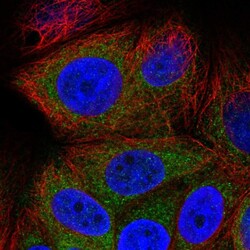Antibody data
- Antibody Data
- Antigen structure
- References [3]
- Comments [0]
- Validations
- Immunocytochemistry [1]
Submit
Validation data
Reference
Comment
Report error
- Product number
- HPA024616 - Provider product page

- Provider
- Atlas Antibodies
- Proper citation
- Atlas Antibodies Cat#HPA024616, RRID:AB_10599728
- Product name
- Anti-GREB1
- Antibody type
- Polyclonal
- Description
- Polyclonal Antibody against Human GREB1, Gene description: growth regulation by estrogen in breast cancer 1, Alternative Gene Names: KIAA0575, Validated applications: ICC, IHC, Uniprot ID: Q4ZG55, Storage: Store at +4°C for short term storage. Long time storage is recommended at -20°C.
- Reactivity
- Human
- Host
- Rabbit
- Conjugate
- Unconjugated
- Isotype
- IgG
- Vial size
- 100 µl
- Concentration
- 0.1 mg/ml
- Storage
- Store at +4°C for short term storage. Long time storage is recommended at -20°C.
- Handling
- The antibody solution should be gently mixed before use.
Submitted references GREB1 is an estrogen receptor-regulated tumour promoter that is frequently expressed in ovarian cancer
Structurally Novel Antiestrogens Elicit Differential Responses from Constitutively Active Mutant Estrogen Receptors in Breast Cancer Cells and Tumors
17β‐estradiol upregulates GREB1 and accelerates ovarian tumor progression in vivo
Hodgkinson K, Forrest L, Vuong N, Garson K, Djordjevic B, Vanderhyden B
Oncogene 2018;37(44):5873-5886
Oncogene 2018;37(44):5873-5886
Structurally Novel Antiestrogens Elicit Differential Responses from Constitutively Active Mutant Estrogen Receptors in Breast Cancer Cells and Tumors
Zhao Y, Laws M, Guillen V, Ziegler Y, Min J, Sharma A, Kim S, Chu D, Park B, Oesterreich S, Mao C, Shapiro D, Nettles K, Katzenellenbogen J, Katzenellenbogen B
Cancer Research 2017;77(20):5602-5613
Cancer Research 2017;77(20):5602-5613
17β‐estradiol upregulates GREB1 and accelerates ovarian tumor progression in vivo
Laviolette L, Hodgkinson K, Minhas N, Perez‐Iratxeta C, Vanderhyden B
International Journal of Cancer 2014;135(5):1072-1084
International Journal of Cancer 2014;135(5):1072-1084
No comments: Submit comment
Supportive validation
- Submitted by
- Atlas Antibodies (provider)
- Main image

- Experimental details
- Immunofluorescent staining of human cell line MCF7 shows localization to mitochondria.
- Sample type
- Human
 Explore
Explore Validate
Validate Learn
Learn Immunocytochemistry
Immunocytochemistry Immunohistochemistry
Immunohistochemistry